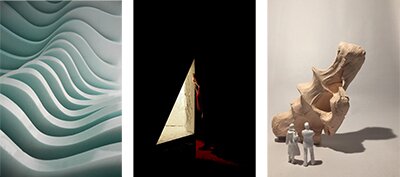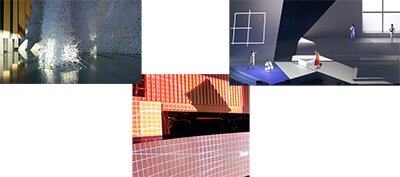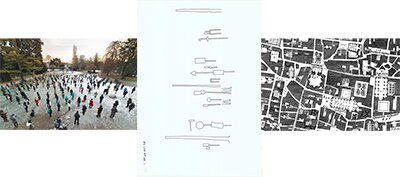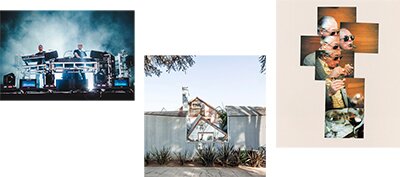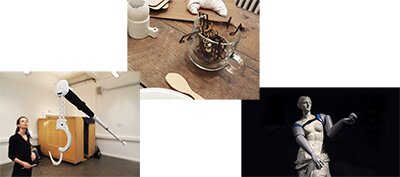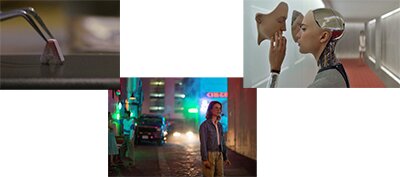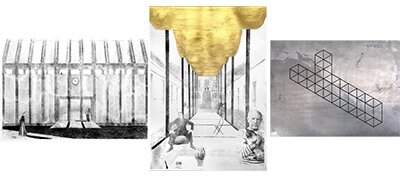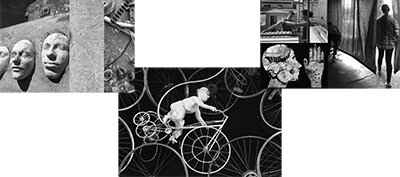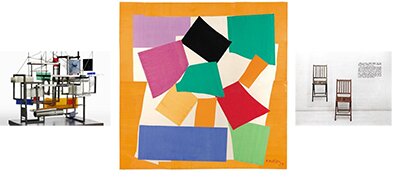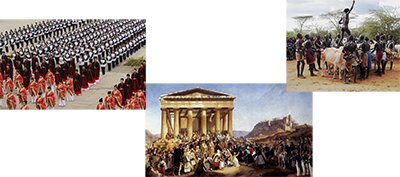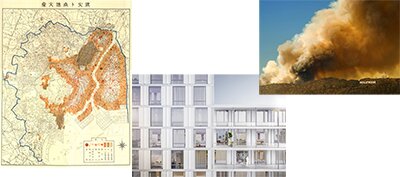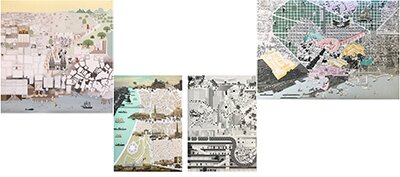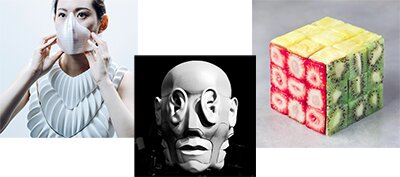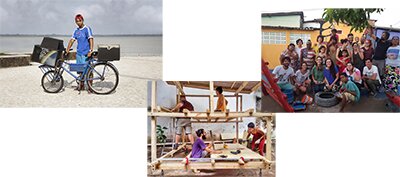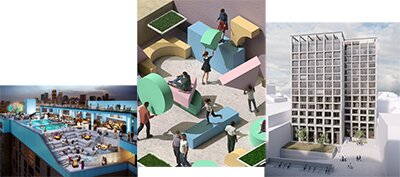#1 Materiate
by José Cadilhe
MATERIATE*
In a time where great part of architectural production is driven by icons and narratives, liminality offers a fresh platform to engage alternative methods of thinking. Liminality implies a transformative space; it evokes the endless, liquid, negative, and mysterious. Liminal space is not focused on size or shape but rather on material expression and abstraction. It is envisioned as an emergent outcome from the process of making, enabling new spatial possibilities and forms of transgression. Here, the latter instigates a critical approach towards boundaries and conventions.
Materiate, is a material based workshop that will provoke students to engage negative spaces instead of prescribing the positives that contain them. Function or uses will not be given but emerge from resulting spatial qualities. A series of analogue models are expected to be produced using different supports. These may include plaster, cement, polystyrene, wax or others. The experiments will enable students to grasp material behaviour and value its transformative energy as an architectural expression. Serendipities are stimulated to liberate the creative process and investigate new design methods.
To enhance discussion and collaboration, the workshop will be structured in small teams so students can develop their projects collectively. Group discussions will also be encouraged to gather different thoughts on processes of formation and ultimately, set a framework between matter and liminality.
*Materiate - Adjective
Philosophy
1 - Produced from matter; having physical substance; composed or consisting of matter.
2 - Metaphysics. Of a form: embodied in matter.
Origin
Late 16th century; earliest use found in Abraham Fraunce (1559–1593), poet and lawyer. From post-classical
Latin materiatus constructed, embodied in matter, a material thing from classical Latin māteria + -ātus.
https://en.oxforddictionaries.com/definition/materiate
#2 liminal habitat
by Helena Dietrich and Rocio Marano
This workshop proposes an embodied approach to design. We are questioning the preconceptions about what a body is and from which body, environments are designed: A body who is not a concept or image but a multilayered experience, formed by sensations, emotions, thoughts, memories, dreams, fantasy.
It is through a body that we experience environments; a body is the starting point to engage with and shape the spaces around and in-between us.
Students will be guided into sensorial and movement exploration of their body and their environments from a visual to a tactile perspective and from experiential anatomy to imaginary body designs. These explorations might alter or deconstruct one’s selfperception and create awareness of the complex architectures of bodies and their relations to environments. It is from this awareness that we start to design interior surroundings.
The workshop is in itself is a liminal space where we deliberately wish to linger in a state of non-definition or not-yet-formed. We want to take the time to develop modes of production that value uncertainty, delay, floating attention and dream-like states as part of a design process. Opposite to how we often deal with problem solving on a rational level, the embodied approach puts lived experience at the core of the process.
What kind of unknown identities and spaces does this approach open?
#3 MATERIAL SCREEN
by Marion Devillers and Lise Pérot
The addition of the image to reality gives both
a new dimension, a kind of fourth dimension.
Abel Gance
Is liminality a tangible space? Is liminality a defined moment?
This workshop consists in designing and manufacturing a tangible sculptural space which is modified by video projections. We will start to define its shape, its structure and the scale of its material and porosity to light, as well as the ability of this space device to act as a screen.
A liminal space has the qualities of an intermediary space. It precedes a space as it closes another. It is both the space and the time of change and of continuity. Liminality is subordinate and conditioned by this before and this after.
We will aim to materialize this opening moment to highlight its deep articulation nature.
The challenge will be to make possible the simultaneous perception of the moments leading up and following the liminality moment. In order to increase this spatial potential, we will try to minimize it physically, as we will try to make it infinite by the projected images.
These sound images, based on the volume, will change the perception of space and will allow manipulating time. They will lead to intimate as to the infinitely large.
Thus we will seek a hybridization process where deepens its in-between character.
Marion Devillers is a sculptor and an architect; Lise Pérot is a scenographer. Throughout this collective adventure, our respective practices will complement each other to accompany the birth of this composite space.
Linearity - Simultaneity - Fragmentation - duplication
What will be the Visual narrative, which will be played here?
#4 Liminal Cadaster - mapping spaces of transition
by Franziska Hederer and Nayari Castillo-Rutz
Liminal or transitional spaces are existing urban environments that show tensions among users and towards their relation to space. They represent zones within different social milieus, antagonist geographical topographies, architectural and urban discrepancies with diverse political claims. Liminal spaces are highly ambivalent: they are not used by people in the way that architects and urban designers have planned them.
When we map a city in terms of these thresholds, many elements need to be considered, such as the interplay between personal experiences within the space and the spatial relational phenomena. Tools for perceiving and understanding these liminal spaces offer new ways of dialog, encounters and negotiation. A basic method to investigate liminal spaces is the Liminal Conversation, which is dialogical method and at the same time an instrument of analysis — consist of a facilitated conversation where different users of a given space, come together to start a conversation around problems or diverse viewpoints. This conversation is hosted in-situ, allowing issues to be resolved/addressed on the spot.
The workshop will revolt around the mapping of Liminal Spaces. Students would be encouraged to identify the thresholds, use or create tools to understand the space (f.e Liminal Conversation) and to generate a cadaster (Nolli Map, Parcours etc.) highlighting the characteristics of the different spots.
#5 MULTIPLICITY
by Anna and Eugeni Bach
The workshop reflects on the idea of permanent change as a stage of normality – a fluctuating stasis where the direction of the change, or the finality of it, has become indifferent or at least diffuse. Liminality, or the process of becoming something, is stretched in time instead of being a passing moment.
We call multiplicity the recognition of the independent character of the parts from the whole. Every element tries to respond to its specific needs and conditions. The relationship between the parts and the whole is collaborative, flexible and imperfect, working not towards a finished product, but as an open system, allowing changes, additions and subtractions. Multiplicity offers a design strategy that addresses change and the idea of becoming instead of being.
This workshop introduces multiplicity as a means to interpret the existing world of architecture, art, design, music, … as well as a design strategy for new interventions. We invite students to detect situations of change, and investigate strategies of additions and subtractions that modify existing realities into structures that intrinsically allow permanent transformation.
#6 Fight Stigma with Critical Design
by Anne Britt Torkildsby and Kristof Vaes
The next generation of designers must face challenging issues relating to inclusion, equality, and diversity! To eliminate prejudice and discrimination they must ensure that stigma is a high priority when developing products, services, environments, etc.
Thus, those responsible for addressing upcoming challenges, i.e. future ‘universal design thinkers’ (Torkildsby, 2017), must be adequately equipped with methodological tools as well as valuable experiences of interdisciplinary work - both essential to preparing them for real-world challenges.
'Critical design' is all about using design to explore issues and ask questions, rather than to directly provide answers/solutions to problems. In doing so it can promote new ways of thinking about the design of assistive devices that have come to provoke stigma-burdened responses. As a potential tool to influence societal and cultural values, critical design can supply a healthy challenge to current interests and tacit values in mainstream design practice and business. The combination of provocative and sensitive elements into campaigns or social design interventions can also exert a positive influence on social attitudes towards assistive devices.
The results of using critical design during a design process is called critical design examples (CDEs; Torkildsby, 2014), which, in the context of this workshop, aims to question the student’s assumptions and preconceived ideas about design and stigma. The CDSs represent ‘Liminality’ as they demonstrate what does not work in our society today - and at the same time give direction regarding what the future could look like.
Pictures
- 'Can't you see?'; a white can that was to be fastened to a visualle impaired person using a handcuff (illuminating the challenges of being dependent on assistive technologie) (IDW2018)
- 'Can you taste the music?'; a confusingly set breakfast table on which nothing smelled, looked, sounded, or felt as it should have (shedding lights onhow it can be to live with Synesthesia) (IDW2018)
- A new outfit with 3D-printed prosthetic limbs, for the Venus de Milo and other statues, made by the nonprofit Handicap International (raising awareness of the global need for prosthetics)
#7 The 'Analogue' CITY
by Chiara Cavalieri and Michaël Stas
Cities are today at the threshold of a technocratic control which relies on digital information and data accumulation: worldwide every two days more data is being produced than in all of history prior to 2003. At the same time, although a certain physical inertia, over the last decades cities and territories have been radically changing, while their representation became more and more controversial: paradoxically, despite the large availability of data and new technologies, representations herefrom are overwhelming and blurring the real complexity of spaces, whilst cantilevering towards the generation of anxiety and simultaneous prosperity.
But until which extend data are tangible? To whom belongs this monitored information? And for what is it (ab)used? The workshop aims to visualize, reveal and ultimately design an analogue image(ning) of invisible(s) via exchange between transcalar mapping process and on site re-act-ion.
What if we start to tackle this reality by experiencing places without the support of digital? What if we start to list and map all those devices (wi-fi; shared mobility devices, money transfer hubs, traffic and control cameras, waste collectors, weather sensors, water level monitors…) that are producing such data, in an analogue way? What if we reveal the threshold between the fluxes of such information and their physical output into our cities?
Pictures
- © Chiara Cavalieri
- from Lewis Carroll, Sylvie and Bruno Concluded, Chapter XI, London, 1895
- © Michaël Stas
#8 The new normal
by Yalenka Mariën and Justine Syen
In the new normal workshop we’ll use design fiction to create provocative and immersive installations that will make the audience question future scenarios. When thinking of the future, we can see positive scenarios, but also frightening ones.
We often think about “What if…” From the rise of robots changing the way we work to the disappearing of binary gender norms. These notions are not new, but are not yet a reality, we are on the verge - an in-between state.
As creators we can learn from the storytelling artistry of science fiction. Design fiction uses narration and prototyping to confront an audience. The result helps to grasp the mindset of our audience, but more importantly challenge and eventually change it.
You’ll work in groups on one of these “challenges”. Through multiple iterations the groups will build a scenario and make it come to life through a prototype, confronting their future with people in guerrilla tests on the streets of Antwerp. The final result will be an immersive installation that will create strong emotional responses.
As creatives, we don’t want to predict the future but shape it and design fiction can help us do that.
Pictures
- Netflix original series Maniac questions not only artificial intelligence in science but also the notion of “buying” or accessing true happiness.
- In the Black Mirror episode “San Junipero” is an example of a more positive narrative that questions mortality and the existence of a heaven on earth.
- The movie Ex Machina explores ethics, artificial intelligence and our desire to understand “humanity” through mimicking it.
#9 1:1
by João Quintela and Tim Simon
Under the theme of LIMINALITY we want to propose the workshop 1:1 as an exercise to research and explore the undefined boarders between designing and representing in Architecture.
We want to think and develop a project together with the students using just the real scale to design an intervention for a specific place. Instead of reducing the ideas to small models or scaled technical drawings our intention is to make closer approaches to the project itself with the use of real scale drawings and atmospheric paintings.
This approach leads us to different questions about designing methodologies but also put in crisis the idea of representation and reality. We take the words from Rosalind Krauss to reinforce an idea of "Architecture in the expanded field" and with this in mind we ask ourselves once a real scale representation of an architectural project could be the project itself or even when a simple painting is closer to architecture than any other discipline.
Our goal during the workshop is to work on different issues that we have been researching through our own practice and academic experience over the past few years.
#10 SHAKEN NOT STIRRED // STIRRED NOT SHAKEN
by Gro Rødne and Nina Haarsaker
Being in a design process always challenges us into being in the in-between, the liminal and the uncertain. Like the definition of the threshold concept1 you have to cope this troublesome state of transformative uncertainty, to traverse and gain new understanding, cognition and recognition. In other words: A creative process implies that you bold and brave have to endure and handle to be in a place where you do not know the answer yet. During this week we will use different tools – and the resources of the group, to challenge our self. Like the cat Cheshire answers Alice, when the road divides: Where do you want to go?

1What are the Threshold Consepts? In any discipline, there are certain concepts - the ‘jewels in the curriculum’ - whose acquisition is akin to passing through a portal. Learners navigating such spaces report a sense of uncertainty, ambiguity, paradox, anxiety, even chaos. The liminal space may equally be one of awe and wonderment. See more at: https://www.ntnu.edu/transark/about or https://www.ee.ucl.ac.uk/~mflanaga/thresholds_in_practice
#11 The most utopian hour
by Filip Collin and Quinten Vermincksel
In our reflections into the project we got to the artist Joseph Kosuth, who’s work we can relate to in the concept of liminality.
Kosuth's thematization of semantic congruities and incongruities can be seen as a reflection of the problems which the relations between concept and presentation pose. Kosuth uses the related questions, "how meanings of signs are constituted" and "how signs refer to extra-lingual phenomena" as a fundament to discuss the relation between concept and presentation.
We translate liminality, applying the theories of Kosuth, into ‘the most utopian hour’. Here we make a connection between space and time in which we find the theme of this week. The first step is to find concrete links within space and time and how these two can limit one another. This leads up to a path through the schools neighborhood where images and objects get registered. Afterwards the collected images get analyzed / abstracted / conceptualized. This with the purpose of making a library of shapes what can be used to put together new compositions as a translation of the world around us within the limits we live.
We aim for the students to work with different kinds of media and set the computer aside. The goal is an installation set up by the student. The different courses of the faculty can come together and work to inspire one another.
The idea is to incorporate the different levels of design to enhance the interaction between the courses. The students will be inspired by connecting different concepts to the given references throughout the project and develop language of images.
The result is a multimedia installation that uses film, objects, collages and other kinds of interpretations of the different shapes into one image.
Pictures
- Constant Nieuwenhuijs : Klein Labyr (1959)
- Collages Henri Matisse: Snail
- Joseph Kosuth: One and Three Chairs
#12 Rituals of citizenship / Allegiance to a post-nation world
by Traumnovelle
"One thing States tend to is the continuation of their own existence"
Iain Banks, The Player of Games, 1988
Methodological nationalism posits that nation-states - and their boundaries - are at the roots of the definition of identities. Yet, at a time when cultures are becoming more enclosed and more global, we need new definitions of belonging and citizenship.
The state of liminality describes a period of transition between two definitions of the self ; it implies the suspension of a previous identity, the dissolution of order which enables new structures to emerge. Rites of passage give rise to the new self in its belonging to a different social group, and mark the acceptance of new rights and duties. They are political tools of transformation of the self aimed at maintaining existing social and power structures.
What if these rituals could become tools for political transformation? How can we define rituals of citizenship, both individual and collective, which testify to a shift from the nation-state to a new political paradigm of universality?
"Rituals of Citizenship" will simultaneously explore the underlying values, hopes and dreams of this post-nation-state world, as well as both the social practices and spaces which support these values. What is it to be a citizen? What are the secular temples of this global citizenship? But above all, what are the universal values which can offer un-hegemonic unity?
#13 Common Ground
by Henry Ng, Isaiah Miller and Qiyao Li
In 2017, years of drought and record high temperatures sparked wildfires across the Western United States, burning over 34,000 km2 - an area larger than the country of Belgium. Los Angeles is facing the worst fires in modern history, reminiscent of the great fires in Chicago, London and Tokyo in previous centuries. The traditional solutions for containing fire in dense cities are ineffective in the sprawling network of dry landscape and detached houses. The very California urbanism that has become an icon of the American dream has magnified its vulnerability.
Climate experts are calling these patterns of extreme, destructive weather the “New Normal”. The severe effects that have been predicted as the world warms to the critical 2°C threshold, such as mass drought and flooding, are already here. Addressing climate change today requires not only mitigation through carbon reduction, but also adaptation to a world in transition. Just asthe burning of Chicago in 1871 cleared the way for the modern city, there is opportunity today to reimagine the shared environment of tomorrow. Collective intelligence and action are needed to rethink the networks, infrastructure, and ecologies of our cities.
Common Ground asks participants to design a model community in the Hollywood Hills that is protected against seasonal wildfire. The workshop looks to fire as an opportunity to bolster our urban networks and to imagine new forms of networked resilience and collectivity. Participants will explore the idea of boundary at multiple scales, between the natural vs manmade, individual vs collective, and protected vs vulnerable.
#14 People in Motion
by Saurabh Mhatre and Venkatkrishnan Ashok
For ages people have been in Motion: Economical transactions. Religious expansions. Wars. Colonisation. Rural exodus. Slavery. Great explorations. Circulation of knowledge. Climatic disruptions. Grand tour. Tourism. No matter the reason, people moved and shaped architectures and territories in response to their mobility. The past century considerably accelerated this phenomenon with the increase of speed and the breakthrough of connectivity.
The aim isto analyse these evolutions in relation with the broader notion of urban morphology and mobility in the urban scenario of Antwerp. How humans were moving, are moving, and how they will move in the future? How their forms of motion affected and will affect the city, infrastructures, buildings and bodies?
The design process will also investigate precedents of avant-garde architecture and heavily focus on new ways of shaping architecture and bodies in space through movement. The broad range for interpreting what motion means will provide the opportunity to discover and create new forms of spaces and behaviours.
We will work by making speculative drawings that propose new forms of organisation, large scale models that explore form. These will be tools that allow the politics of the project to be explored through form, space and materiality.
#15 Media-Tasting: Why Do You Design?
by Dian-Jen Lin and Hannes Hulstaert
Why do you design? What defines your practice?
Are you shaping your practice with free will or are you being confined by the givens of your practice?
Liminality is not a comfortable space, especially for graduate students. Without guidance and a clear compass in mind, one can easily get lost amid the pressure of time, money, peers and family. However, how many of you know if you are heading in the right direction?
In this comprehensive yet intensive workshop of transdisciplinary design marathons, the participating students are invited to map out their personal ambitions, dreams and current efforts as the designer of their own life. Once personalised trajectories are set, they will be used as starting points for a series of experimentation through several channels - media-tasting. The participants will start with design sprints and brainstorms and then a brand-new design challenge will be introduced every day. Followed by rapid prototyping sessions and daily presentations, constructive assessments and open discussions will feed into their future practices and help them differentiate their uniqueness among the group.
The media we will be tasting includes - but not limited to - fashion design, audio-visual arts, hacking (bio/tech) and food design. The media will be inducted and the participants can play, experiment and design with these new tools to create prototypes and projects.
#16 T.A.D. - Terreiro* Activation Device
by Lula Marcondes and Diego Inglez de Souza
Terreiro* Activation Device - Manifesto for an Intercultural Placemaking
Terreiro:
Strip, space or portion of flat and extensive land. Space of land used for cultivation. Unshrouded earth space. Small yard, usually clay, located on the exterior of a house; terrace or roof. Place for the celebration of Afro-Brazilian cults: terreiro de macumba. Type of square in portuguese and brazilian cities and villages. Place of celebrations, rituals, demonstrations and meetings.
The Idea:
Design and build a mobile device, object or furniture as a key element to trigger, through a celebration with food and music, an intercultural integration at the public spaces. This device will be designed as a multifaceted object set up to host live and electronic music and to work as a booth to cook and serve food. Brazilian culture and references as a strategy to congregate and mix different populations, origins and ages living in liminal social and urban conditions in specific sites of Antwerp.
The Project:
- Design and build the T.A.D. using mainly recycled materials and transforming existing objects;
- Design a graphic content for the Manifesto;
- Connect with people/place/community with a diverse cultural and social texture;
- Propose the activation of the space through T.A.D.;
- Advertise the encounter;
- Design and build musical instruments for the Street Orchestra that integrate public and players on corteges that follows the movements of the T.A.D. and celebrates its arrival in a ritual;
- Set up the T.A.D. with traditional food from the different social/ethnic groups;
- Set up the T.A.D. with sound and video equipment to play music and videos;
- Organize and curate another editions and places where T.A.D. can be, suggesting audio and visual contents coordinated Smith social and cultural activites for the T.A.D.
Student may be interested in:
- Hands on projects;
- Art;
- Music;
- Visual Poetry;
- Social and cultural issues;
- Challenges beyond comfort zone.
#17 Shift/Share
by Christelle Gualdi
Liminality is a very attractive and resourceful concept in architecture. It can be defined as the conceptual, ephemeral relationships between people and spatial environments. Most traditional architectural practices are orientated around building programming and objects rather than human experience.
Life itself, fictions, experiences and situations, all transitional moments are the starting point of my architectural approach: designs where life stories and potential can unfold.
What kind of spaces and identities do we create for those different states of being? What are the qualities of liminal spaces and what kind of (enriched) life experiences can they bring?
With these questions applied to the workshop, we could approach transitional spaces, liminal spaces as moments that can give birth to thoughts. Moments when creativity will open the door to future opportunities.
Your own student life in our fast changing and challenging society becomes a great base for engaging active design strategies. A period where you move across the limits of what you were towards what you will be.
We will use the reconversion of the Prinsenhove student housing complex in Antwerp as a case study to explore and challenge innovative and integrative designs informed by liminality. We have here the opportunity to see the potential for transition and transformation of an existing structure in an existing social context.
You become able to create your own life fictions from this transition. We will work on the blurred lines of private and shared spaces, requalify time in space use, dissolve social boundaries, challenge preconceived ideas, question appropriation and stimulate potential to create new realities.
